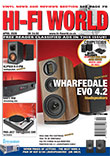KLS9 loudspeaker |
Page 1 of 2 This article is reprinted unaltered from Hi-Fi World DIY Supplement No28, April 1997 issue. It is published for reference purposes for those who use KLS9s today. We do not supply kits anymore, and cannot help with parts, service or technical queries.

KLS9 LOUDSPEAKER Noel Keywood designs and builds a high technology, but inexpensive 2-way floorstanding loudspeaker that gives real bass.
Up to now, our loudspeakers have been a little different to the norm. but this design, KLS9, deliberately uses a conventional format: it's a two-way floorstander.
There are two reasons. Everyone wants to know how to design a loudspeaker and a two-way is an easy place to start. KLS9 is something of a design exercise. Secondly, by using high quality drive units and not skimping on the cabinet size-wise, it is relatively easy to produce an inexpensive design that is easy to build but offers superb performance. In fact, when I think about it, I don't know why we haven't built this 'speaker before.
CHOOSING THE DRIVE UNITS In a two-way 'speaker, the bass unit must cover a wide frequency range, from the lower limit set by the box, all the way up to meet the tweeter, around 3kHz. Because this covers not only the bass region but the midband too, it is called a bass/midrange unit. It is asking a lot of any driver to work over such a range and in practice most bass/midrange drivers get a bit rough in the crossover region, from 2kHz-4kHz. Using a small cone minimises this problem, but the drive unit then has to work hard moving air to produce bass. Bass distortion rises and low frequency power handling deteriorates.
To achieve reasonably good power handling, as well as deeper bass with more punch, an 8in cone is needed. This is the most popular choice amongst manufacturers and it has been my choice for KLS9. To maintain quality above 2kHz, I have chosen to use a High Definition Aerogel (HDA) cone driver from Audax, the HM210ZO. This is one of their most advanced designs. HDA is composite material comprising Kevlar and Carbon Fibres, aligned along the polymer chain of an acrylic gel. The cones are actually baked hard, although they retain a peculiar slight stickiness to their front surface. HDA is extremely light, yet rigid, with optimised internal damping. Audax fit the unit with an edge wound voice coil of flat copper wire, mounted on a heat resistant Kapton former, and the whole assembly is supported by a rigid cast Mazak chassis, not a cheap pressed steel affair.
Modern synthetic cones are more consistent in their properties than paper types, giving a clean sound even at high volume. Paper 'breaks up' badly, sounding sharp and coarse. By the way, the instrument that puts most harmonics into the break-up region of a bass/midrange cone is violin, which is why violin sounds so different between speakers.
The tweeter I chose to use was the well tried and tested Audax TWO25MO. This uses a fabric dome for good sound quality (I would not use a metal dome by the way; they are too hard and clattery). It comes down far enough to meet the bass/midrange unit at around 3kHz and it has enough sensitivity to match. Finally, it is very reasonably priced.
THE CABINET Not unsurprisingly, when the Thiele-Small parameters of the HM210ZO are plugged into a computer programme to calculate box volume the optimum figure turns out to be the size of a conventional floorstander. That's because nowadays, drive unit manufacturers tailor parameters to produce a drive unit optimised for a real life cabinet. The HM210ZO suits a medium-to-large ported cabinet.
From experience we have found it best to go for a high pass response that produces a little bass peaking around the 30Hz-60Hz region. This gives real weight to bass, which most listeners prefer. With the HM210ZO, using a box volume of 2.6cu. ft. (0.075 cubic metres), bass reaches down to 36Hz (-3dB), which is low. You will find that our cabinet is 0.072 cubic metres volume in fact, but internal sound absorbent makes the cabinet appear bigger as far as the drive unit is concerned.
Generally speaking, the larger the cabinet the better - up to a limit. If you make the cabinet for this driver any larger than 2.6cu ft in volume it will start to peak up in the bass, sounding boomy and one-note. What I have done is to choose the highest volume figure possible, consistent with flat response, meaning +1dB of peaking at 40Hz.
Computer predicted response of the HM210ZO drive unit in a 2.6 cu ft enclosure. Output rises by +1dB or so around 50Hz, then falls away at 24dB/octave. This is a classic reflex, high-pass box response, with a -3dB frequency of 36Hz in this case.
This gives low box Q, good damping and a relatively clean step response, suggesting solid sounding bass with good weight but little overhang. Practice bore out theory; KLS9 delivers very deep, tight bass. It can really thunder. Conveniently, for this volume of cabinet, dimensions can be set to give a large but not monstrous floorstander, measuring 93cms high, 25cms across the front panel and 38cms deep.
However, cabinet volume can be reduced, up to 50%, by those who might want a smaller 'speaker or lighter bass. The best approach here is to knock up a pair of experimental cabinets of 2.6cu. ft volume and then slowly reduce volume with bricks until you get the bass quality you are after. The bass drivers can be removed to get the bricks in, or the rear panels if they are screwed in place.
|








